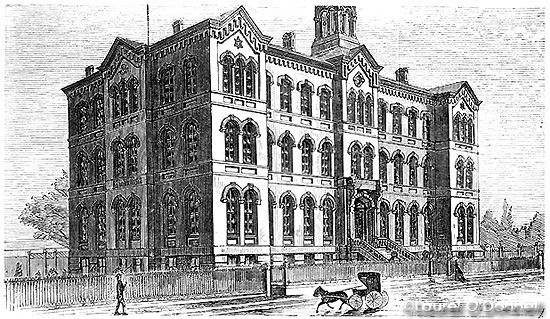|
|
Chapter V
Institutions of Manhattan Island and Westchester Co.
Hebrew Benevolent and Orphan Asylum Society
of the City of New York (Seventy-seventh street and Third avenue.)
 ON the 8th of April, 1822, a number of gentlemen of the Jewish persuasion, residents of the city of New York, organized the "Hebrew Benevolent Society," which was incorporated by act of Legislature February 2, 1832, granting power to hold real and personal estate, the annual income of which should not exceed $2,000. The objects of the society were stated to be "charitable, and to afford relief to its members in cases of sickness and infirmity." In January, 1845, the "German Hebrew Benevolent Society," a rival organization, sprang up, which was the same year incorporated, and exerted a large influence for fourteen years. The objects of this organization, as set forth in its act of incorporation, were—"to assist the needy, succor the helpless, and protect the weak." The proceedings of this society were transacted and the minutes kept in the German language. In 1847 this society voted $1,500 out of its general fund, and a portion of its annual receipts, toward the erection of a hospital. The Hebrew Benevolent Society promptly united in this movement, but, as the wealthier congregations withheld their support, the enterprise failed for lack of means. In 1859 the German Society having voted to appropriate the hospital fund for the establishment of an orphan asylum, and a home for aged and indigent Jews, and the opinion having become general that the cause of charity would be promoted by a union of the two societies, they were happily united, and a supplementary act of incorporation passed April 12, 1860, under the title of the "Hebrew Benevolent and Orphan Asylum Society of the City of New York." The new organization proposed "to relieve the sick, succor the poor and needy, support and comfort the widow, clothe, educate, and maintain the orphan." This was to be done by the establishment of a well-regulated system of out-door relief for the poor; by founding and maintaining an asylum for Jewish orphans; and by establishing a home for the support of the aged poor. Any Israelite may become a member of the society on the payment of one hundred dollars. The business of the society is conducted by a president, vice-president, a treasurer, and eighteen trustees, six of whom are annually elected at the meeting of the society in April. The last act of incorporation granted power to hold estate, the income of which should not exceed $15,000 ; authorized the city to grant land to the society for the erection of suitable buildings; and clothed it with the same power to manage and indenture orphans that had been given to other societies. In 1861 the Corporation granted a beautiful plot of ground on the corner of Seventy-seventh street and Third avenue, and the sum of $30,000 toward the erection of an asylum. The corner-stone of the building was laid September 30th, 1862, and the edifice formally dedicated November 5, 1863. The Asylum consists of a main building and two wings, the principal front, on Seventy-seventh street, being one hundred and twenty feet, with a depth of sixty, and cost $40,000. It is constructed of brick, is three stories high, besides a high basement and sub-cellar. The ceilings are high, the half wide, the apartments conveniently arranged with all the modern improvements, and crowned everywhere with completest order and tidiness. The lecture-room (or miniature synagogue), like every other part of the Institution, is replete with Jewish taste and trimming. A yard one hundred and twenty-five feet by one hundred and two, lying between the Asylum and Third avenue, is devoted to a beautiful flower-garden, and ample play-grounds are furnished in the rear. The Superintendent, Louis Schnabel, is a Jewish rabbi, and conducts the services of the Institution. At the opening of the Asylum fifty-six orphans, who had been provided for by the society in various places, were transferred to it, and the number has since reached one hundred and fifty-eight, the full capacity of the building. The children attend the public schools daily, where they generally excel in their studies, and when promoted to the grammar department they also take up the study of Hebrew in the Asylum. These Hebrew scholars are divided into five classes, and many of the students attain a fine education. Experimental workshops have recently been added, which if successful will soon be greatly enlarged. Ninety-five of the one hundred and fifty-eight in the Institution during 1869 were born in New York, and the remaining sixty-three represented eleven of the American States, and seven of the countries of Europe and Asia. Eight were admitted at the age of five, two at seventeen; the larger portion are, however, received between the ages of seven and twelve years. Indentures are made only to Hebrews of good standing. Eight members of the board of directors are constituted a committee of charity and relief, who investigate by personal visitation the circumstances of all applicants. During During 1869, 3,926 persons were relieved at an expense of $13,425. One hundred and forty-six persons were assisted to go West, South, or to return to friends in Europe. The Hebrew fair, held during the last year, and one of the most successful ever held on Manhattan by any society, netted the Asylum $35,000, and the Mount Sinai Hospital over $100,000. |
|
164
:: Previous Page :: Next Page ::
:: Table of Contents :: :: New York State :: :: History Readings :: Books & articles appearing here are modified adaptations
from a private collection of vintage books & magazines. Reproduction of these pages is prohibited without written permission. © Laurel O’Donnell, 1996-2006.
|
|


